
USS Essex was a 1000-ton ironclad river gunboat of the United States Army and later United States Navy during the American Civil War. It was named by her captain, William Porter, for his father's old sailing frigate, the USS Essex. This Essex was originally constructed in 1856 at New Albany, Indiana as a steam-powered ferry named New Era.

The Battle of Arkansas Post, also known as Battle of Fort Hindman, was fought from January 9 to 11, 1863, near the mouth of the Arkansas River at Arkansas Post, Arkansas, as part of the Vicksburg Campaign of the American Civil War. Confederate forces had constructed a fort known as Fort Hindman near Arkansas Post in late 1862. In December of that year, a Union force under the command of Major-General William T. Sherman left for an expedition against Vicksburg, without Major-General John A. McClernand because neither Major-Generals Henry Halleck nor Ulysses S. Grant trusted McClernand. After Sherman's force was repulsed at Chickasaw Bayou, McClernand arrived and took command from Sherman in January 1863.

USS Hartford, a sloop-of-war steamer, was the first ship of the United States Navy named for Hartford, the capital of Connecticut. Hartford served in several prominent campaigns in the American Civil War as the flagship of David G. Farragut, most notably the Battle of Mobile Bay in 1864. She survived until 1956, when she sank awaiting restoration at Norfolk, Virginia.

USS Carondelet (1861) was a City-class ironclad gunboat constructed for the War Department by James B. Eads during the American Civil War. It was named for the town where it was built, Carondelet, Missouri.

USS Cairo is the lead ship of the City-class casemate ironclads built at the beginning of the American Civil War to serve as river gunboats.

The first USS Lafayette was a side wheel steamer, converted to an ironclad ram, in the United States Navy during the American Civil War.
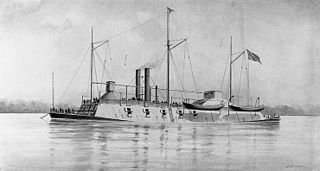
USS Benton was an ironclad river gunboat in the United States Navy during the American Civil War. She was named for American senator Thomas Hart Benton. Benton was a former center-wheel catamaran snagboat and was converted by James B. Eads, St. Louis, Missouri, in 1861 and commissioned February 24, 1862 as part of the Army's Western Gunboat Flotilla.

William David Porter was a flag officer of the United States Navy. He was the son of Commodore David Porter (1780–1843) and brother of Admiral David Dixon Porter (1813–1891) as well as foster brother of Admiral David Farragut (1801–1870).

Laurent Millaudon was a wooden side-wheel river steamboat launched at Cincinnati, Ohio, in 1856 operating in the New Orleans, Louisiana, area, and captained by W. S. Whann. At the beginning of the American Civil War she was taken into service by the Confederate Navy as CSS General Sterling Price. On 6 June 1862, she was sunk at the First Battle of Memphis. She was raised and repaired by the Union army, and on 16 June 1862 was moved into Union service as USS General Price and served until the end of the war.

USS Marmora was a sternwheel steamer that served in the Union Navy from 1862 to 1865, during the American Civil War. Built in 1862 at Monongahela, Pennsylvania, as a civilian vessel, she was purchased for military service on September 17 and converted into a tinclad warship. Commissioned on October 21, the vessel served on the Yazoo River beginning the next month. She encountered Confederate naval mines on the Yazoo on December 11, and was present the next day when the ironclad USS Cairo was sunk by two mines. After further service on the Yazoo during the Battle of Chickasaw Bayou in late December, Marmora was assigned in January 1863 to a fleet that was preparing to operate against Confederate Fort Hindman, but was not present when the fort surrendered on January 11.

USS Baron DeKalb was a City-class ironclad gunboat constructed for the Union Navy by James B. Eads during the American Civil War.
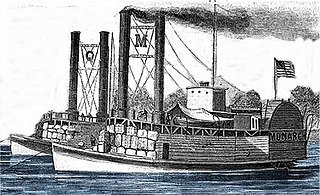
USS Monarch was a United States Army sidewheel ram that saw service in the American Civil War as part of the United States Ram Fleet and the Mississippi Marine Brigade. She operated on the Mississippi River and Yazoo River during 1862 and 1863.

The City-class ironclad USS Cincinnati was a stern-wheel casemate gunboat in the United States Navy during the American Civil War. She was named for Cincinnati, Ohio, and was the first ship to bear that name in the United States Navy.

USS Mound City was a City-class ironclad gunboat built for service on the Mississippi River and its tributaries in the American Civil War. Originally commissioned as part of the Union Army's Western Gunboat Flotilla, she remained in that service until October 1862. Then the flotilla was transferred to the Navy and she became part of the Mississippi River Squadron, where she remained until the end of the war.

USS Pittsburgh was a City-class ironclad gunboat constructed for the Union Army by James B. Eads during the American Civil War, and transferred to the Union Navy in October 1862. She was commissioned in January 1862, Commander Egbert Thompson in command.
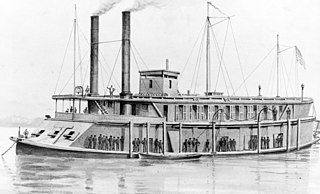
USS Rattler was a steamer acquired by the Union Navy during the American Civil War.

USS Eastport was a steamer captured by the Union Navy during the American Civil War. She was used by the Union Navy as a convoy and patrol vessel on Confederate waterways.
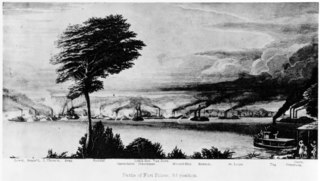
USS Sumter was a 525-ton sidewheel paddle steamer captured by the Union Navy during the Union blockade of the American Civil War.

The Pook Turtles, or City-class gunboats to use their semi-official name, were war vessels intended for service on the Mississippi River during the American Civil War. They were also sometimes referred to as "Eads gunboats." The labels are applied to seven vessels of uniform design built from the keel up in Carondelet, Missouri shipyards owned by James Buchanan Eads. Eads was a wealthy St. Louis industrialist who risked his fortune in support of the Union.
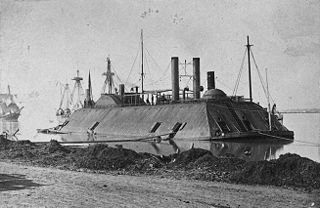
The Battle of Lucas Bend took place on January 11, 1862, near Lucas Bend, four miles north of Columbus on Mississippi River in Kentucky as it lay at the time of the American Civil War. In the network of the Mississippi, Tennessee and Ohio rivers, the Union river gunboats under Flag Officer Andrew Hull Foote and General Ulysses S. Grant sought to infiltrate and attack the Confederate positions in Tennessee. On the day of the battle, the Union ironclads Essex and St Louis, transporting troops down the Mississippi in fog, engaged the Confederate cotton clad warships General Polk, Ivy and Jackson and the gun platform New Orleans at a curve known as Lucas Bend in Kentucky. The Essex, under Commander William D. Porter, and the St Louis forced the Confederate ships to fall back after an hour of skirmishing during which the Union commander was wounded. They retreated to the safety of a nearby Confederate battery at Columbus, where the Union vessels could not follow.




















